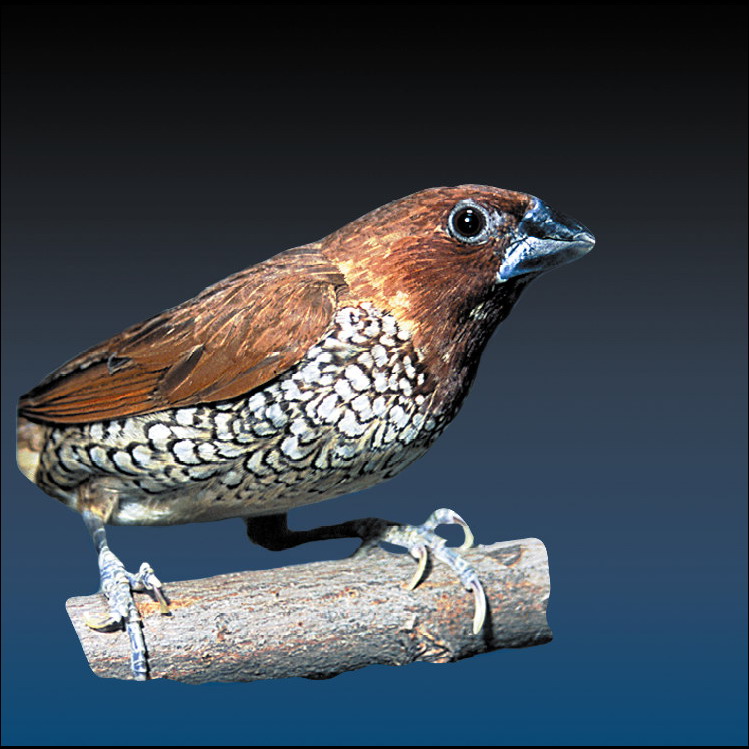Scaly-breasted Munia, Spice Finch (Lonchura punctulata) {!--얼룩무늬납부리새--> Scaly-breasted Munia
Lonchura punctulata
Scaly-breasted Mannikin/Finch, Spotted Munia, Spice Bird/Finch, Nutmeg Finch, Pipit Pinang (Malay)
Scaly-breasted Munias are among the most common Munias and are now quite common in Singapore too. They are found even in urban areas as well as cultivated lands, grasslands, scrub, secondary growth. But they were not so common in earlier records, suggesting that they could have been introduced.
Scaly-breasted Munias specialise in eating grass seeds and sedges, and have large conical beaks adapted for this purpose. They feed both on seeding heads on grass stems, as well as on ripe seeds that have fallen to the ground. They may also snack on small berries, such as those of the Lantana bush. Some have been seen picking at road kills.
Scaly-breasted Munias are highly gregarious and forage in small flocks, sometimes with other Munia species.
A large flock foraging in grass would move in a regular pattern. First a few birds would move forwards, followed by another few, and so on in waves. Or the birds at the back would leap-frog over the birds in front. Once a grass patch is thoroughly worked through, the whole flock would fly off to another patch. Smaller flocks feed haphazardly. At the end of the day, they may gather in flocks at the topmost branches of a bare or open tree, calling to each other. They then disperse to roost in smaller groups or pairs within nests, even outside the breeding season. Sometimes, up to a dozen birds may squeeze into a nest. These roosting nests are spread far apart. They may also roost with other Munias or even with weaver birds.
Breeding: Scaly-breasted Munias breed year round and may have multiple broods on a good year, up to 3-4 broods. The males perform a courting song, which may attract another male or even several. These males perch close to the singer and peer intently at his bill. This behaviour is called "peering". A male also entices a female by flying about with a bit of grass in his bill and flickering his wings and tail. If the female is interested, she too picks up a bit of grass and flickers her wings.
Scaly-breasted Munias build well hidden nests 4-5m high in thorny bushes, trees, creepers, or high in the crowns of palms. Often, the only way you can spot the location is to see the bird carrying nesting material into its hiding place. Sometimes they nest in bushes infested by ants, which appear to leave the birds alone and provide them some protection. Unlike their roosting nests, breeding nests may be built closer together in a colony. The male brings nesting materials while the female builds, often from the inside. In some, the breeding nest is later used as a roosting nest.
The nest is an untidy globe made out of grass and bamboo leaves, with a side entrance. It is lined with soft fluffy seeds or feathers. The nest are not woven and material is simply pushed together. But the nests are well-made, robust and waterproof. The birds work tirelessly and the nest can become an enormous globe. 5-6 white eggs are laid, although sometimes more eggs are found, probably laid by more than one female. Both parents incubate. The eggs hatch in about 2 weeks and the young are fed entirely vegetable matter, which is regurgitated by the parents. They fledge in 18-19 days. Juveniles often form their own flocks after leaving their parents, and wander about together.
Scaly-breasted Munias are often hunted by birds of prey. When a flock flies some distance, although the whole group flies in a a direct manner, within the flock, each bird follows an erratic corkscrewing path. This makes it hard for birds of prey to target a single individual.
Status and threats: Scaly-breasted Munias are often considered a pest on paddy and other grain crops. Children are encouraged to destroy their nests as a means of controlling them. In some countries, they are caught in large numbers for the table, and for the pet trade.
